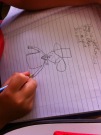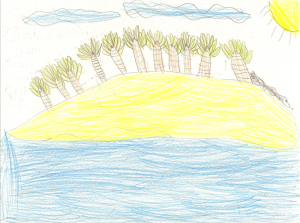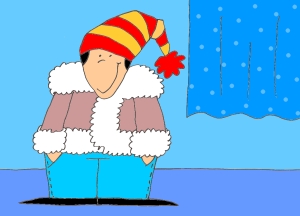What does your dad do
My students were learning names of jobs and what people do, for instance, a police officer keeps our community safe, a firefighter puts out fires, a taxi driver drives around town, etc. After a few classes and significant practice, we wrapped this lesson up with a writing task in which they wrote about their parents´ jobs. We used an app called CHATTER PIX, which allows users to add a voice to a picture. No need to mention they had a blast! Videos
OPTION 2: Students draw themselves in the clothes of the professional they want to become when they grow up and write about it. They can explain their choice by using a reason or an adjective.
Examples:
1) When I grow up, I want to be a doctor because I want to help sick people.
2) I want to be a vet because I love animals and I want to help sick animals.
3) I want to be an architect because I think it´s interesting/fun/lucrative.
In the end, they record their text by using CHATTER PIX.
Tip: Allow students to practice reading their text before recording it, so you can correct any pronunciation difficulties they may have.
Draw your vacation
This is an opportunity for students to learn personal information about the teacher. The ultimate goal is to engage students into writing and make them familiar with simple writing techniques. Show students drawings of your last vacation. Don’t worry if you don’t draw well. The fact that you drew them will encourage your students to do the same. Also, show short simple sentences for each drawing. Make sure, students identify and understand the three parts of a paragraph:
1) TOPIC SENTENCE: It tells you what the paragraph will be about;
2) BODY: It is developed around the topic sentence usually with examples and details;
3) CONCLUSION: It restates the introduction with different words.
Also, make sure students are familiar with “connectors”. After showing your students your sentences, allow them some time to draw and write about their own vacation. Have colored pencils and blank sheets of paper available on your desk in case they don´t have those. You can also assign this task for homework. At home, they will scan and upload their drawings and write about them. They can make a video or a power point slide presentation to show in the following class.
Resolutions 2015
Ok, here we go again! It’s time to think about our resolutions for 2015. Have you made your list yet? I usually don’t bother, but I’m putting my foot down. I’m going to lose weight starting on Monday. My plan is to lose 11 pounds in the next 6 months. How about you?
Elections 2014
Last october, Brazilians voted for president and unlike previous elections, this one was marked by fearce and really nasty comments of the candidates about their opponents’ character. Instead of talking about their platform, they attacked each other trying to make them look unreliable to the voters (which explains the opening remark in the video). Thus, I took this opportunity to assign a project for my teen students. Since they were learning the first conditional, they were supposed to pretend they were running for president and create a political platform in which they stated what they would do in case they won. They were supposed to use the possible starters below:
1) If you vote for me, I will… 2) If I win this election, I will… 3) If I have your vote/ support, I will… 4) If you give me a chance, I will…
When they finished writing their platforms, I proofread them and provided them with comments and suggestions. After that, the students used the school’s IPads to design a poster, in which they would draw a symbol for their campaign, think of an “imaginary” party/number and come up with a catch phrase. The drawing app they used was DRAWP because it’s super user friendly.
Once their posters were done, we filmed their platforms. I projected their posters on the data show screen and they read their material. I suggest that they practice for awhile before recording the video. (However,as much as they rehearse, they will always mispronounce one, two or some of the words. Believe me, I’ve tried. As much as I recorded them again, a new mispronunciation occurred. Inspite of that, they consolidated the structure, which was a big deal). The videos are time consuming, therefore, I suggest that you assign this project to only one group of few students. I had 8 students In this class.
To wrap things up, we had an election in school. We set up a room with the video on, a ballot and voting slips displayed on a desk. Everyone going past the room was invited to go inside, watch the video and vote for one of the candidates.
In the end, the winner got a token.
Resolutions
My teen students learned how to talk about resolutions by using GOING TO. To wrap things up, they were asked to illustrate a song. This particular group was not very into drawing. Nevertheless, I wanted to give you an idea of what the video could look like, so here‘s the result:
How old are you?
Super simple activity for practicing HOW OLD ARE YOU? with elementary students. I usually draw first to demonstrate what I expect from them.
1) Write the following on the board:HOW OLD ARE YOU? I´m___________.
2) Hand out sheets in blank;
3) Students draw and color their age (They draw a big number in the center of the sheet);
4) Students tape them to their chest;
5) Students walk around the classroom and practice Q/A; (They will continue until they have talked to every one)
Happy Birthday!

After being introduced to vocabulary related to birthdays (gifts, party, cake, balloons, and names of toys) my students also learned to congratulate someone for their birthday and how to ask Yes/No questions with the verb TO BE.
Student 1: Happy Birthday!
Student 2: Thanks.
Student 1: This is for you. (a gift)
Student 2: Thank you very much! Is it a …….?
Student 1: Yes, it is.
Student 1: Happy Birthday!
Student 2: Thanks.
Student 1: This is for you. (a gift)
Student 2: Thank you very much! Is it a …….
Student 1: No, it isn’t. It’s a ………
5) After that, I chose the pairs and called them out and two by two, they acted out the conversation above and exchanged their gifts. Remember that during the dialog, they have to guess what the gift is by asking “Is it a ….?” In case the student doesn’t guess it at all, you can encourage students to ask “What is it?” In my class, there was one student alone, so I participated by drawing one gift myself. During the dialog, students exchanged their gifts and sat down.
6) In the end, they glued their gift drawing to their notebooks and wrote a thank you letter.
What’s there in your island?
After learning the verb THERE TO BE, my students drew an island and described it by using the vocabulary learned:
Drawing Dictation
This is a super simple activity. I usually do it as a warm up after students have practiced ANY vocabulary presented. It consists in dictating the words and having students draw them. They have a laugh! As they draw them, you can tell whether they understand the vocabulary or not. Another option here is to have students draw them in their notebooks instead. You can also dictate the colors. For instance: “Draw a ladybug and color it red and black” (to make the task more fun, you can say different colors, instead.)
My favorite singer
Students are learning how to describe their talents. After practicing the structure ” I can… but I can´t …” and learning the names of the musical instruments, I assigned the following written task: Draw and color you favorite singer and write about him/her.
His X Her
Students this semester drew a cowboy/cowgirl to describe their clothes by using HIS or HER, CLOTHES and COLORS. First, I drew a cowboy as a model. Then, I took photos of their cowboys while they were drawing them and after they all had finished, I took a photograph of each and showed them on the data show equipment, so they described them. They were supposed to use: His pants are…., his scarf is… his shirt is… his boots are… and his hat is…
Story Telling: Simple Past X Present Perfect
Dani Lyra, my dear workmate, asked me to draw a story to teach the Simple Past and the Present Perfect. A story in which these two tenses would be the main characters. Here is the thing: At first I thought I could record my voice telling the story, which I did, but afterwards I realized it would be more interesting to write the story, so you could memorize it and tell it yourself. Believe me, it’s a lot more fun!
PICTURE 1: Simple Past and Present Perfect were friends when they were little. They played, laughed and had a lot of fun together.
PICTURE 2: Eventually, Simple Past became a cowboy.
PICTURE 3: Present Perfect became a surfer.
PICTURE 4: Simple Past is very likable, straightforward, easy to understand.
PICTURE 5: Present Perfect is not easy to understand.
PICTURE 6: Sometimes some people prefer to think he doesn’t exist.
PICTURE 7: Some frown at and look down on him.
PICTURE 8: And many people have misconceptions about him…
PICTURE 9: …which makes him upset.
PICTURE 10: Simple Past is super attached to the past.
PICTURE 11: Every time he tells you about something he did, he will tell you “when”.
PICTURE 12: And if you tell him that you traveled on your vacation, he will ask you when. And he will always use DID in questions.
PICTURE 13: Present Perfect has an eye in the present.
PICTURE 14: Simple Past is obsessed about time…
PICTURE 15:…whereas Present Perfect doesn’t even have a watch. He doesn’t care when something happened. Sometimes it’s because he doesn’t remember.
PICTURE 16: Present Perfect always uses HAVE and the participle of a verb.
PICTURE 17: In questions, too.
PICTURE 18: He uses HAS for the third person.
PICTURE 19: All these differences made them go separate ways, but it doesn’t mean they are alone.
PICTURE 20: Simple Past has friends that hang out with and enjoy his company. They are always together.
PICTURE 21: Although some people don’t understand Present Perfect, he has friends, too. Loyal friends who relate to him and are always there for him.
The Fridge Song
STEP 4: The powerpoint presentation provided for the activity allows students to write their own version of the song, so they are arranged in small groups and work on what food items they will use in it. When they finish, they write their version of the song on the board.
STEP 5: Finally, they share their song with all their peers.
P.S. Steps 1 and 2 are interchangeable.
COOL TIP:
A nice activity to be done on the following day is:
1) Arrange students in two teams.
2) Project the images of the students’ fridges’ drawings and give them 1 minute to memorize them.
3) Ask them questions using IS THERE ANY…? and ARE THERE ANY…?
Rules for the Classroom
The drawings below were used to practice Rules in the Classroom. Having these pictures on the wall helps students remember what the teacher expects from them. The original drawings were rough sketches that I made on paper, so I didn’t have them in the computer and later I threw them away. The ones in the digital book are the new ones. I decided to digitalize them, so they would last longer.The images have been used to teach students the affirmative and negative forms of the Imperatives.
Creative Writing
An adult student during a reading activity: “Teacher, what’s yawning and frowning?”
Landscapes
My little ones learned vocabulary related to an island and how to describe it by using the verb THERE TO BE. They drew a landscape and described it. Click on the link below to see a few:
Family Members – Option 2
After practicing the family members and how to introduce them, students are given sheets of paper and instructed to fold them and draw the members of their family. Some students have very big families, so instruct them to draw just the ones that live with them. Afterwards, they write about them using the structure learned.
Step 1: FOLD The number of folded parts will depend on the number of people in the student’s family. (Sometimes, it is very difficult for them to fold the sheet, so you can do it for them. Ask them how many people they have in their family and fold it accordingly.)
The number of folded parts will depend on the number of people in the student’s family. (Sometimes, it is very difficult for them to fold the sheet, so you can do it for them. Ask them how many people they have in their family and fold it accordingly.)
Step 2: DRAW
It is only necessary to draw one on the first rectangle. (Point out that the ends of the arms and legs have to touch the edges of the sheet. )
Students cut it out. (This step may be even more difficult than folding, so you might need to cut a few in order for them not to wreck it.)
In the end, give each student a colored sheet of paper. Students paste their family and write about them. Collect and display them on the walls. You can also digitize their work, so their parents can see it. Here is an example.
Adjectives

Daily Routine
Family Members
Young Learners: MEMBERS OF THE FAMILY
 We practiced the structure below for some time (about three classes) and after that, I used the slides and elicited the missing words. Students learned the possible ways to talk about their family:
We practiced the structure below for some time (about three classes) and after that, I used the slides and elicited the missing words. Students learned the possible ways to talk about their family:
This is Anna. She’s my mom.
To wrap it up, students drew the members of their family. Point out that they are supposed to draw only the people that live with them. After drawing them, students wrote about them. (You can take a photo of their drawings and project them using the data show equipment. Students then introduce their families to peers.)Teens: SUPERLATIVES
The same drawings have been used in order to practice the Superlatives. After practicing the forms of the superlatives with different adjectives, students were to write about their family members.
How’s the weather today?
A Short Biography
Dani Lyra asked me to make a set of drawings about John Lennon´s biography in order to use it as a teaser.The teaching point here is the past form of the verbs. The teacher prints the images and displays them randomly. Students guess the sequence of events and come up with the story. Afterwards, teacher plays the video, so students can check the correct order. The other way around is also possible, that is, show students the video first and then, check whether they remember the sequence. In the end, students research information about late famous people and write a short biography each. They can also draw them, which is the most fun part of the project. Here are a few questions to guide them:
1) When and where was he/she born?
2) What did he/she do?
3) When and how did he/she die?













































